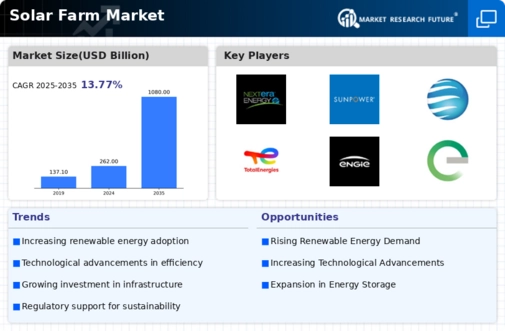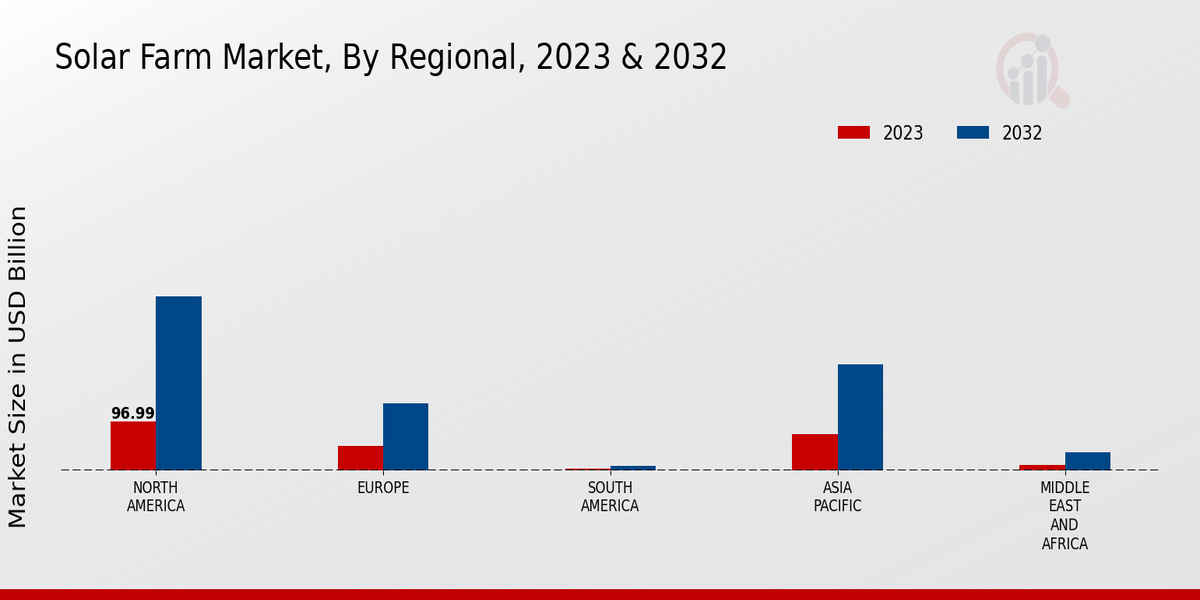Market Growth Projections
The Global Solar Farm Market Industry is projected to experience robust growth over the coming years. With a compound annual growth rate (CAGR) of 13.74% anticipated from 2025 to 2035, the market is set to expand significantly. By 2024, the market is valued at 262.0 USD Billion, and it is expected to reach 1080.0 USD Billion by 2035. This growth is indicative of the increasing adoption of solar energy technologies and the ongoing investments in solar infrastructure. The market dynamics suggest a favorable environment for stakeholders, including investors, developers, and policymakers, to capitalize on the opportunities presented by the transition to renewable energy.
Rising Demand for Renewable Energy
The Global Solar Farm Market Industry is experiencing a surge in demand for renewable energy sources, driven by increasing awareness of climate change and the need for sustainable energy solutions. Governments worldwide are implementing policies to reduce carbon emissions, which has led to a significant shift towards solar energy. In 2024, the market is valued at approximately 262.0 USD Billion, reflecting the growing investment in solar infrastructure. This trend is expected to continue, with projections indicating that by 2035, the market could reach 1080.0 USD Billion. The transition to renewable energy is not only environmentally beneficial but also economically advantageous, as it creates jobs and stimulates local economies.
Government Incentives and Subsidies
Government incentives and subsidies are pivotal in shaping the Global Solar Farm Market Industry. Many countries offer financial support to encourage the adoption of solar energy, including tax credits, grants, and feed-in tariffs. These initiatives lower the upfront costs associated with solar installations, making them more appealing to investors and homeowners alike. For instance, in the United States, the Investment Tax Credit allows for a significant deduction on federal taxes for solar energy systems. Such policies are instrumental in driving market growth, as they not only stimulate investment but also promote the transition towards a more sustainable energy landscape.
Increasing Energy Security Concerns
The Global Solar Farm Market Industry is also influenced by rising energy security concerns. As nations seek to reduce their dependence on fossil fuels and foreign energy sources, solar energy presents a viable alternative. The diversification of energy sources enhances national security and stabilizes energy prices, making solar farms an attractive investment. Countries are increasingly recognizing the strategic importance of energy independence, which is likely to propel the growth of solar energy projects. This shift towards self-sufficiency in energy production aligns with global efforts to combat climate change and promote sustainable development.
Growing Corporate Sustainability Initiatives
Corporate sustainability initiatives are becoming increasingly prevalent, significantly impacting the Global Solar Farm Market Industry. Many corporations are committing to renewable energy targets, aiming to reduce their carbon footprints and enhance their corporate social responsibility profiles. This trend is evident in various sectors, including technology, manufacturing, and retail, where companies are investing in solar energy to power their operations. By 2035, the market is projected to reach 1080.0 USD Billion, driven in part by corporate investments in solar farms. As businesses recognize the long-term financial benefits of renewable energy, the demand for solar installations is expected to rise, further contributing to market growth.
Technological Advancements in Solar Technology
Technological innovations play a crucial role in the Global Solar Farm Market Industry, enhancing the efficiency and affordability of solar energy systems. Advances in photovoltaic technology, such as bifacial solar panels and solar tracking systems, have improved energy capture and reduced costs. These innovations are likely to drive market growth, as they make solar energy more accessible to a broader audience. The continuous development of energy storage solutions, such as lithium-ion batteries, further supports the integration of solar energy into the grid. As technology evolves, the cost of solar installations is expected to decrease, making solar energy a more attractive option for both residential and commercial applications.
























